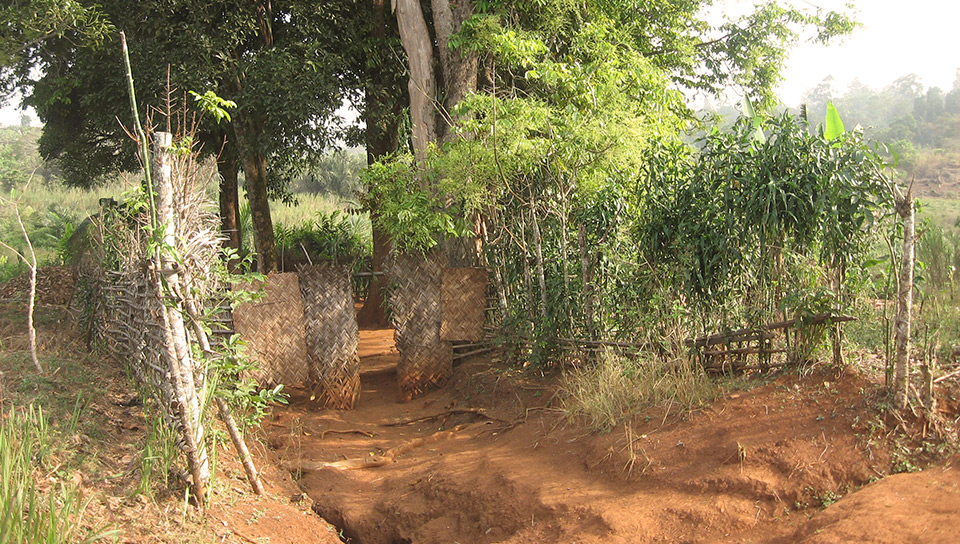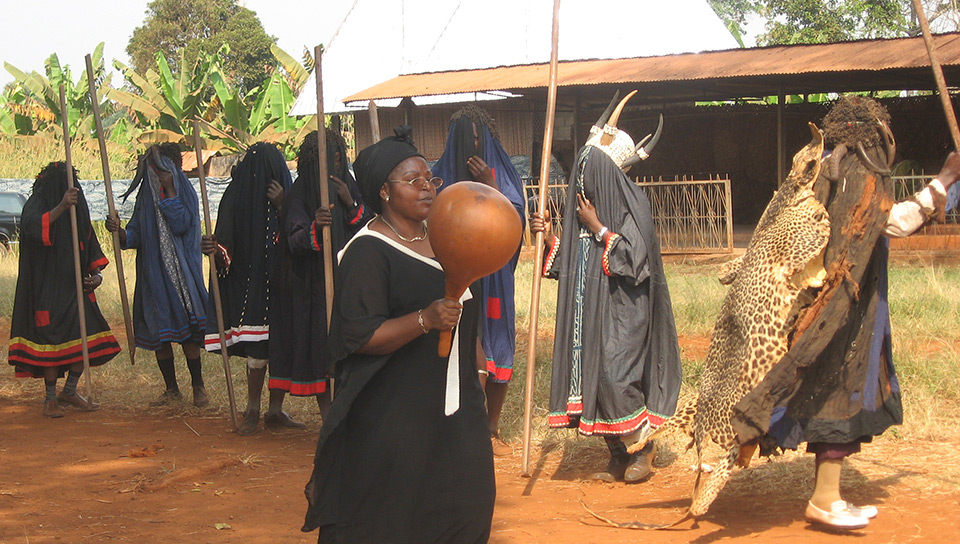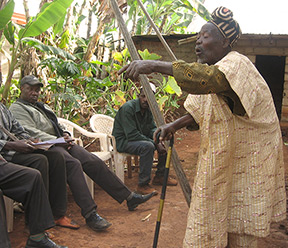Í Bandjoun yfirráðasvæði í Vestur Kamerún liggja ýmsar síður skynja sem heilagt af heimamönnum. They are the remnant cores of sites that were historically a lot more extensive representing the identity of tribes and communities in the region. The character of separate sites differs in terms of function and the social group that makes use of it. Two examples are family shrines, usually with presence of a fig tree (Ficus sp.), and community gathering places which constitute centres of traditional initiations to the community life. The hluti hlutverk flestum stöðum er dýrkun guðanna. Jafnvel þótt vistfræði þessara helgu náttúrusvæða hefur fengið litla athygli til þessa, þeir eru þekktir fyrir að hafnar dýra og plantna sem hafa að mestu horfið frá nærliggjandi svæðum.
Hótun
Traditional leaders stated that the survival of sacred areas is not threatened because these areas are strongly linked with the community identity. Nevertheless they worry about the changing attitude of young people who are becoming increasingly materialistic and disobey taboos and show lest respect for ancestral beliefs. Í dag, margir nota helgu svæði án þess að upplýsa vörsluaðila þeirra, gefur til kynna rof menningar viðmiðum. Meira helstu ógnir hafa verið greind, enn flestir eru undir umræðu meðal heimamanna sjálfra.
Infrastructure development, especially road construction and urban settlement, has caused the degradation of sacred areas in Bandjoun. The expansion of Christianity offers alternative views on the need for protection and honesty. Some Christian priests are said to have a diabolic view on the sacred sites. According to some local traditional spiritual leaders the fact that for Christian’s punishment of wrong deeds comes after death, while for local beliefs punishment takes immediate effect increases people’s disobedience of the ancestral beliefs and taboos.
Hins vegar, a decreasing influence of Christianity on local beliefs is also reported as well as an increasing willingness of Christian priests to listen to locals and work on an interfaith understanding. According to some, even modern education can have a negative impact on traditional beliefs, due to the decreasing time children spend with their parents. Auk þess, the changing lifestyles cause a decreased interest in traditional values putting the continued care for these sacred natural sites at risk.
Vörsluaðila
Gegnum aldirnar, að Bandjoun fólk hefur þróað með ancestral stjórnun kerfi helgu náttúrusvæða. Staðsetning náttúrulegum og hálf-náttúrulega heilagt staður er auðkenndur með hafin andlegum leiðtoga (MkamSi, Guèkè). Þó flestir hafi verið lengi þekkt, the location of a sacred area is not immutable and can be changed for reasons like road construction or socio-political reorientation. Almennt, hver heilagt svæði koma á ábyrgð vörsluaðila heitir Nongtchuép. Hann er ábyrgur fyrir að gera tilboð og fórnir, sem hann getur einnig umboð fulltrúa. These are initiated elders who are universal custodians. Þeir hafa rétt til að vinna í öllum dýrka síður.
Even though women are generally regarded as heaving little to do with sacred areas, deeper investigation revealed that their role is present, but hidden and ignored. Til dæmis, Megnesi (female equivalent of MkamSi) have the same capacities and duties as their male counterparts. Only the mothers of initiated twins can clean certain sacred sites. A woman can substitute the family chief and make offerings and sacrifices at a sacred place. Ennfremur, the traditional education is primarily given by women who enforce conservation regulations for sacred areas.
Conservation Verkfæri
Eftirfarandi verkfæri fyrir náttúruvernd hefur verið komið svo langt:
- Listi yfir aðgerðir til að taka næstu
- A listi yfir hagsmunaaðila
- Yfirlýsingar af hefðbundnum leiðtoga
- Samfélagsfræðsla innihalda sýn heimamönnum er á aðstæðum
- Hlutdeild kort af helgu náttúrusvæða á svæðinu
Framtíðarsýn
Mesta framfarir styðja verndun helgu sviðum væri lagalega viðurkenningu þeirra, aukin vitund almennings, minni neikvæð breytingar á landnotkun og betri viðurkenningu félags-menningar og vistfræði mikilvægi þeirra. Til að ná allt ofangreint þarf þátttöku hagsmunaaðila á staðnum, landsvísu og alþjóðavísu.
Samtök
Effective and appropriate support is needed for further conservation of these sites. As a possible solution, Bandjoun community members suggest that involving stakeholders like women, young people, félagasamtök, religious institutions and maybe even state institutions to develop management in sacred areas in a participatory way whilst clearly agreeing on the role of each stakeholder.
Aðgerð
Little aðgerð er nú ráðist, nema í nokkrum rannsóknum að hækka vitund fólks Bandjoun sem heilagt vefsvæðum sínum eru í húfi. The Banjoun þurfa stuðning til að greina hættu heilagt náttúrusvæða mikilvægt að samfélög. Þeir vilja til að gera skýra afmörkun þeirra og að þróa viðeigandi stefnu fyrir sjálfbæra stjórnun þeirra.
Stefna og lög
Heilagt náttúruvætti á þessu sviði eru nú ekki viðurkennd löglega. Alls skógur stjórnun er á hendi ráðuneytisins skóga og dýralíf samkvæmt Cameroonian lagalegum styttur.
Sem afleiðing af félagslegu rannsókn, aukin vitund um Bandjoun fólk er mikilvægasta afrek svo langt. Það er útbreitt sjónarmið að aðkoma ríkisins í stjórn Heilagrar náttúrusvæða gæti kynna áhættu og búa til átök. Ríkisstjórn yfirmenn eru grunaðir að vilja viðeigandi úrræði, ætlaði að veikja vald öldunga. Samfélags meðlimir benda vekja vitund almennings, kortleggja og demarcating mörkum heilagt svæði, bæta þekkingu, stakeholders working together and devolving power of the government could all be good solutions to stop the worsening situation.
- Kamga-Kamdem S L., (2010) Ancestral Beliefs and Conservation. The case of sacred natural sites in Banjoun, west Cameroon, í Verschuuren, B., Wild R., McNeeley, J. og Oviedo., G. (Eds.) Sacred náttúrusvæða, Varðveita náttúru og menningu, Jörð Scan, London,.PP. 119-128.






